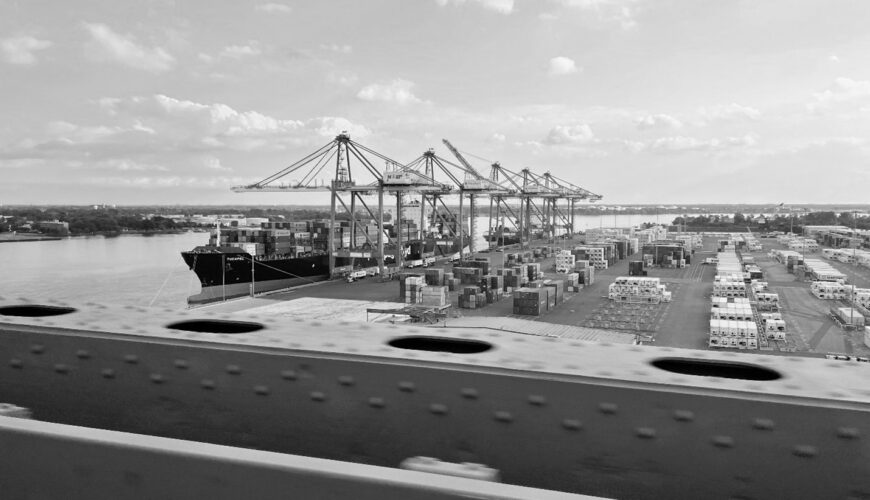The United States container ship seaport system stands as a testament to the intricate web of global trade and commerce. At the nexus of international supply chains, these ports play a critical role in facilitating the movement of goods across continents. With an intricate network that spans coastlines, rivers, and inland transport, this system ensures the timely delivery of products that sustain economies and livelihoods. In this article, we explore the major components of this supply chain ecosystem.
Foundation of Connectivity
The foundation of the U.S. container ship seaport system lies in its connectivity. Situated strategically along both the Atlantic and Pacific coasts, as well as the Gulf of Mexico, these ports are linked to major trade partners around the world. The Panama Canal and the Suez Canal further solidify this global reach by enabling vessels to traverse efficiently between the East and West.
Arrival and Unloading
The journey begins as colossal container ships, often spanning the length of several football fields, dock at these ports. Trained maritime pilots guide these mammoth vessels through intricate channels, ensuring safe arrival. Upon docking, cranes resembling mechanical giants swing into action. These gantry cranes, equipped with advanced technology, can move containers weighing as much as 50 tons with remarkable precision.
The unloading process, though seemingly straightforward, requires an intricate dance of synchronization. Containers are plucked from the ships’ decks and arranged in the order of their oncoming departure. This orchestration minimizes the time ships spend at port, thereby optimizing efficiency.
Land Bridge: Ports to Inland
The sophistication of the U.S. container ship seaport system goes beyond the coastlines. Once unloaded, these containers embark on the next leg of their journey through an intricate network of railways, highways, and intermodal terminals. This land bridge, connecting the ports to various inland destinations, is a testament to the multi-modal nature of modern logistics.
Intermodal yards, where containers are shifted seamlessly from ships to trains or trucks, employ cutting-edge technology. These yards utilize electronic data interchange (EDI) and radio-frequency identification (RFID) systems to monitor the movement of each container in real-time. This ensures a fluid transition from maritime to terrestrial transportation.
Customs and Security
In the post-9/11 era, port security and customs clearance have assumed paramount importance. The U.S. Customs and Border Protection (CBP) plays a pivotal role in safeguarding the nation against illicit trade and security threats. Each container undergoes a rigorous screening process involving both physical inspection and advanced scanning technologies.
Customs clearance, a delicate balance between trade facilitation and security, requires a high level of coordination among various stakeholders. Electronic manifests, filed by importers before a ship even reaches port, provide CBP with advance information about the cargo. This pre-arrival data allows authorities to assess potential risks and expedite the release of legitimate shipments.
Warehousing and Distribution
Once cleared, containers are transferred to vast port warehouses or directly to distribution centers. These facilities, resembling small cities in themselves, are equipped with state-of-the-art infrastructure for storage and handling. Some are equipped with automated storage and retrieval systems (AS/RS) to efficiently manage inventory, while robotic systems expedite the movement of goods within the warehouses.
Efficiency remains a central theme even during the last mile of delivery. Just-in-time inventory management ensures that goods reach their final destination precisely when needed, minimizing holding costs and maximizing operational agility.
Economic Implications
The U.S. container ship seaport system is not merely a logistical marvel; it also holds significant economic implications. Ports serve as crucial economic engines for their respective regions, generating billions in revenue and supporting millions of jobs. The movement of goods through these ports stimulates local economies, from trucking companies to manufacturing industries.
Moreover, these ports are vital cogs in the global trade machine. The ability to handle ever-increasing cargo volumes directly impacts a nation’s competitiveness in the global market. Ports that can efficiently accommodate the new generation of mega-ships gain a competitive advantage, attracting trade routes and further cementing their significance.
Environmental Considerations
While the U.S. container ship seaport system is a testament to human ingenuity, it also presents environmental challenges. The substantial carbon footprint of maritime shipping raises concerns, prompting the industry to explore greener alternatives. Initiatives such as shore power, which allows ships to connect to the electrical grid while docked, reduce emissions and reliance on onboard generators.
Additionally, the dredging of port channels to accommodate larger vessels can disrupt delicate ecosystems. Balancing economic growth with environmental stewardship remains a complex task, necessitating innovative solutions and cooperation among stakeholders.
The Future: Automation and Sustainability
As we peer into the future of the U.S. container ship seaport system, two trends loom large: automation and sustainability. Automation technologies, already prevalent in port operations, will continue to evolve. From autonomous cranes to unmanned ships, the industry will harness artificial intelligence and robotics to enhance efficiency and reduce labor costs.
Sustainability, too, will play an ever more critical role. As environmental awareness grows, ports will adopt cleaner energy sources and implement green practices. Electric cranes, renewable energy installations, and emission-reducing initiatives will shape the ports of tomorrow, ensuring a balance between economic growth and ecological preservation.
Conclusion
The United States container ship seaport system is a marvel of modern logistics, knitting together a global network of trade and commerce. Its intricate processes, from vessel docking to customs clearance, from warehousing to distribution, have far-reaching economic and social implications. As technology advances and environmental concerns mount, the industry finds itself at a crossroads where innovation and sustainability must intertwine to shape the ports of the future. In this dynamic landscape, the U.S. container ship seaport system will continue to be the backbone of global trade, a testament to human endeavor and adaptability.


